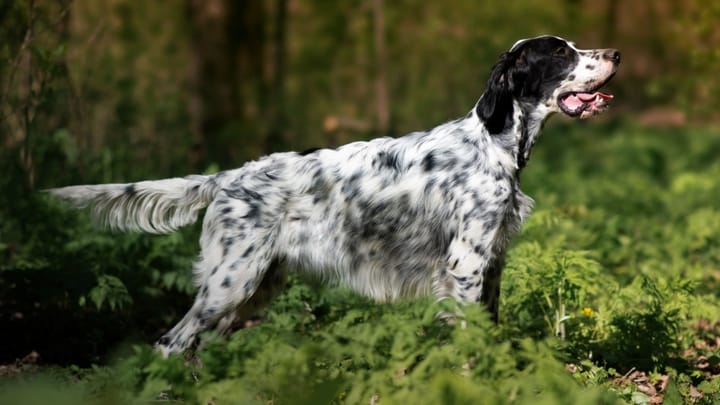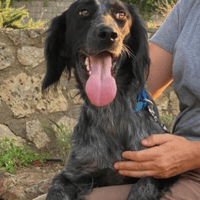English Setter
Other names : Laverack, Llewellin Setter


The English Setter is a pointing dog of medium size that, by all accounts, could be considered the perfect dog. He excels in hunting and proves himself to be a very good companion dog for the whole family. Gentle, attentive, docile and affectionate, with his enthusiasm and social competence, he brings much joy to both little and bigs one alike. Very active, he is best suited to available and fit owners who will be able to meet the dog's many needs for expenditure, which are not to be underestimated.
|
Life expectancy |
The English Setter has a life expectancy of between 10 and 14 years |
|
Temperament |
|
|
Size |
Medium
|
|
Adult size |
Female
Between 24 and 26 in
Male
Between 26 and 27 in
|
|
Adult weight |
Female
Between 44 and 55 lb
Male
Between 44 and 55 lb
|
|
Coat colour
The coat can be a variety of colours :
The term 'belton' was first coined by Edward Laverack- the breeder who contributed to the construction of the race- and designates the flyspeck (or speckled patching) of the dog's coat. Belton is a village in Northumberland (a county in the north of England). |
Black White Brown |
|
Type of coat
The hair is long. The hair is slightly wavy without ever forming into full curls. It is long all over, (2 to 2,5 inches) and silky. Feathering (fringes) can be found around the neck, in the brisket region, on the side of the hind limbs, on the buttocks and on the tail. The undercoat is only abundant in the wintertime. |
Long Wavy |
|
Eye colour
The eyes are hazel, as dark as possible (slightly less dark in white and tan individuals). |
Brown
|
|
Purchase price |
The English Setter costs between £590 and £920 |
As the English Setter is a particularly handsome breed and also highly sought after as a companion dog, certain unscrupulous breeders have contented themselves with selecting lineages for their aesthetic qualities, with little regard for their personalities or hunting predispositions. Actually, in England, the breeding of show dog Setters and hunting Setters has become distinctly separated, as if it were concerned with two different breeds, which is a reprehensible mistake.
More details about the English Setter
English Setter: Origins and history
This dog has very old roots. He is probably a descendant of the ancient Spaniel, also known as the German Spaniel, which was one of the incarnations of the primitive Canis Familiaris Intermedius. The Breed had been established in 1860 by Edward Laverack and would have to wait another twenty years before spreading outside of England. It is one of the most commonly used pointing dogs for hunting.
Physical characteristics of the English Setter
The English setter is the most beautiful of all pointing dogs. It is mesomorphic, with a rather rectangular-shape torso. The head is long, well-defined, light. The length of the skull is equal to that of the muzzle. The skullcap is slightly domed. The stop is pronounced but not abrupt. The eyes are big and expressive.The ears are set low, hanging, adjacent to the cheeks. The back is straight, the kidneys muscular and quite arched. The limbs are perfectly straight. The tail is set high: big and robust at its base, it thins down towards the tip. It is worn rather low, slightly curved outwards like a reversed saber.
FCI classification of the English Setter
-
Group 7 - Pointing Dogs
-
Section 2 : British and Irish Pointers and Setters
English Setter: Characteristics
English Setter: Behaviour
Training a English Setter
As with all good work dogs, the training process is pleasant if it has been initiated early enough, so as to stop any bad habits from developing, and in order to maintain a degree of coherence throughout the dog’s life.
Particularly sensitive, positive reinforcement must be prioritised as this dog will not tolerate any form of brutality or unfounded reprimands, which would only serve to sully the master-dog relationship.
In addition to being precocious, coherent and fair, the training will have to be coupled with an approach that is as firm as it is gentle. This will ensure the best results with this pooch.
The priority is to train hailing which, contrary to what might be expected, will not be that difficult to implement with this English hunting dog. In fact, pointers are often more malleable and docile than hounds, for instance.
English Setter: Lifestyle
Breed compatibility English Setter
English Setter: Purchase price
The price of an English Setter varies depending on its origins, age, and gender. You have to count an average of £915 for dogs subscribed to the Kennel Club.
With regards to the monthly budget required for a dog of this size, including both quality nutrition and basic yearly care (vaccines, deworming, etc.), it is estimated at around £45.
English Setter: Shedding
Heavy !
Hair loss is significant during moulting seasons. During autumn and spring, the brushes will have to be more frequent and carried out on a daily basis in order to remove dead hair.
English Setter: Grooming
The maintenance of this dog may seem complicated on account of his long hair and feathering, but is, in reality, quite straightforward. Weekly brushes/detangling will be necessary.
Every now and again, the fringes can be trimmed a bit to avoid parasites and fungi from developing within the coat.
Grooming will occasionally be necessary, especially after this water-loving dog takes a dip. You will have to be sure to thoroughly dry him after every swim.
Special attention should be given to the ears, which are vulnerable to various infections, not least because of them being folded over.
English Setter: Health
Life expectancy is estimated at 12 years.
As is the case of many respectable active dogs, the english setter is of robust constitution but remains more fragile than a dog that has only minimal expenditure needs.
He can tolerate heat but be careful not to have him be too physically active in hot weather, as his fierce determination might lead to him not being able to restrict himself. Fresh water and a spot in the shade must be made available to him.
This pointing dog is lucky to have an undercoat which develops during winter when temperatures drop. Having said that, do note that extreme weather conditions are not greatly appreciated by this european pointing dog.
If coupled with a quality nutritional regimen, the constant activity of this dog make this him relatively resistant to excess weight. If he gets his share of required exercise, he is not afflicted by obesity.
- Cancer
- Hip and elbow dysplasia
- Congenital deafness
- Ear infections
- Atopic dermatitis (dermatological affliction)













